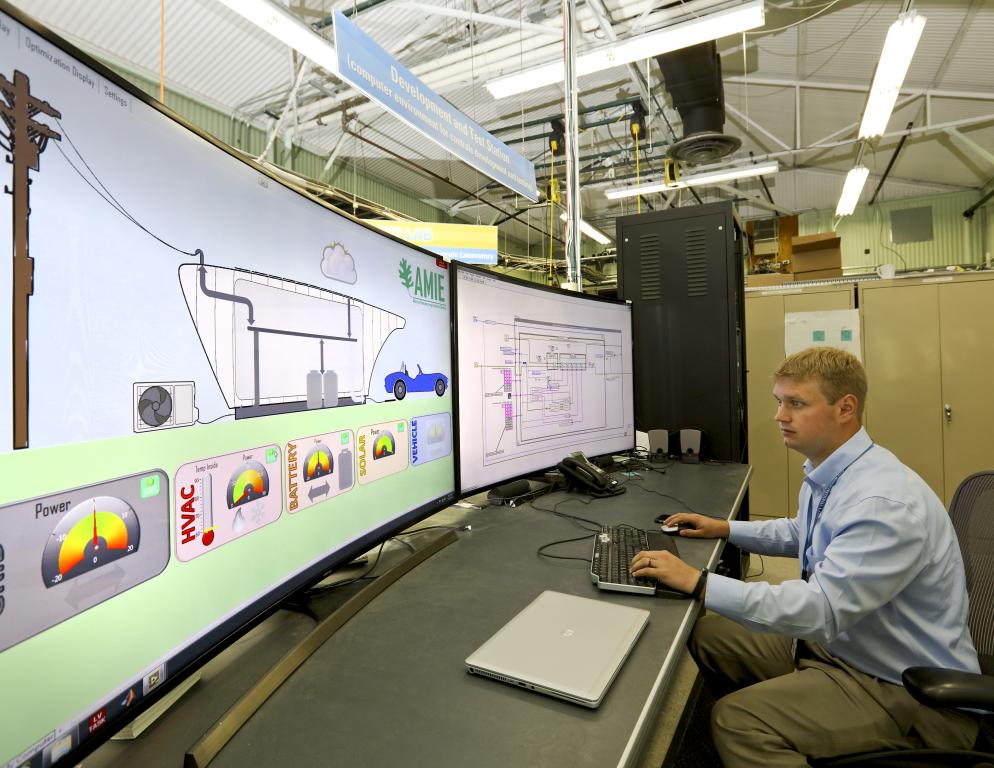
GRIDEYE MONITORING
ORNL's EESR Division, in partnership with University of Tennessee, has a unique wide-area grid monitoring network that provides observation of the entire electrical grid’s dynamic performance continuously and in real time. GridEye uses monitoring devices that are essentially time synchronized single-phase phasor measurement units to capture the dynamic responses (frequency, voltage and phase angle) of the grids to major disturbances such as generator trips and load shedding, as well as provide insight into inter-area oscillations. These monitors, which are deployed all over the world, are low cost and easy to install by connecting at 110V. ORNL is working with industry partners including ISOs, utilities and other organizations.
ELECTRIC GRID WIDE-AREA DYNAMIC MODELING
ORNL is working with the Eastern Interconnection Planning Collaborative (EIPC), comprised of major utilities within the EI, and Eastern Interconnection States Planning Consortium to develop models for the EI. The EIPC has created three scenarios for the future EI grid, representing various levels of new grid infrastructure and wind penetration in 2030. ORNL is the lead support lab for these studies and is currently extending the analysis of cost and operation questions for DOE. In order to understand the implications of large amounts of variable generation on system dynamic performance, it is necessary to establish modeling capability beyond steady-state load flow. ORNL is converting the EIPC models to dynamic models for the purposes of dynamic simulation studies. The models are essential to study dynamic performance and ensure grid reliability. ORNL works closely with UT’s CURENT Engineering Center, focused on wide area visualization and controls to accommodate high levels of renewable energy systems.

PREDICTIVE MODELING AND LOOK AHEAD SIMULATION
ORNL is developing tools for the next generation Energy Management Systems which are faster than real-time by accelerating performance of state estimation systems and moving towards state measurement. By measuring the state of the grid, ORNL can move closer towards its vision of performing on-line contingency analysis and using faster than real-time. Simulation. Additionally, ORNL is developing dynamic simulations and accurate geospatial models for state, power flow, frequency, and voltage. This work is in partnership with IBM, EPRI, Georgia Tech and University of Tennessee.
UNMANNED AERIAL SYSTEMS
The Unmanned Aerial Systems Research Center (UARSC) at ORNL connects industry with world-class research tools and capabilities to translate scientific breakthroughs into commercialized applications. By advancing the engineering and integration of technology subsystems, UASRC maximizes the power of unmanned aerial systems (UAS) to design and develop innovative, transformative solutions that improve safety, productivity, and use.
DISTRIBUTED ENERGY COMMUNICATIONS & CONTROLS FACILITY
The EESR employs the DECC laboratory for testing dynamic voltage and power factor control supplied from DE resources, microgrid operations, protection and controls, energy storage design and integration, buildings integration, AMI Interoperability, SCADA testing, RTDS impact studies, renewables integration, fault induced delayed voltage recovery and other applications. A complete hierarchy of power distribution system testing, such as load changes, startup of dynamic loads, feeder reconfiguration, and relaxed capacitor compensation is available on request. As part of the facility, ORNL is developing and testing methods to regulate voltage locally, control frequency in the case of microgrid islanding and provide an acceptable buffer in the margin-to-voltage collapse. ORNL developed the DECC Lab for testing new dynamic voltage and power factor controls supplied from distributed energy resources and has expanded the laboratory for microgrid control and communications testing. This unique laboratory has installed both rotating and inverter-based technologies and both direct and wireless communications for control of these technologies.
POWERLINE CONDUCTOR ACCELERATED TEST (PCAT) FACILITY
ORNL has built a unique transmission test facility to support the nation’s need to address electricity transmission reliability and security issues. The transmission test facility has been uniquely designed for testing overhead bare transmission line conductors at high currents and temperatures after they have been installed and tensioned to the manufacturer's specifications. The ability to operate a transmission line conductor in this manner does not exist elsewhere in the United States. The objective of the PCAT facility is to accelerate the commercialization of new conductors for power system transmission lines by testing the conductors at their rated temperatures and currents in an outdoor environment.
AMI INTEROPERABILITY TEST-BED
The EESR division has specific smart meter testing capabilities, and also has the capability to disrupt (in a controlled environment) the meter’s radio and thermal environments for the purposes of future testing options. NIST, in collaboration with DOE, has a need for a government-controlled test environment to validate a draft test framework for the NEMA Advanced Metering Infrastructure Smart Meter Upgradeability Standard (NEMA SG-AMI 1). The test environment is to have the key components of an AMI network – a meter, an aggregator, and back-end network management system at a minimum – in order to test upgradeability and security, in accordance with the NEMA standard. While the current need is for this purpose, there are potential follow-on needs related to security testing, Home Area Network functionality, and other areas of interest.

